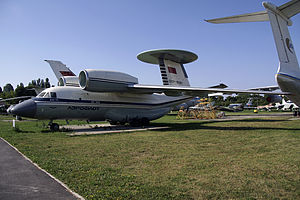Antonov An-71
This article needs additional citations for verification. (November 2012) |
| An-71 | |
|---|---|

| |
| Antonov An-71 at the Ukraine State Aviation Museum | |
| Role | Tactical AWACS
|
| Manufacturer | Antonov |
| First flight | 12 July 1985 |
| Status | Cancelled |
| Primary user | Soviet Air Force (intended)
|
| Number built | 3 |
| Developed from | Antonov An-72 |
The Antonov An-71 (
Background
Soviet Air Force AWACS doctrine
Prior to the fall of the Soviet Union, the Air Force was divided into three aircraft based groups of units. They were the VVS-DA (Voenno-Vozdushnye Sily Dal'naya Aviatsiya) or Long Range Aviation (Bombers), the VVS-FA (Voenno-Vozdushnye Sily Frontovaya Aviatsiya) or Frontal Aviation (Fighters, Fighter Bombers and Attack aircraft), and the VVS-VTA (Voenno-Vozdushnye Sily Voenno-Transportnaya Aviatsiya) or Military Transport Aviation. The PVO (Voyska protivovozdushnoy oborony or Voyska PVO) which was the primary fighter / interceptor and surface-based defensive force was not part of the VVS; as a result, the A-50 Mainstay AWACS aircraft and its predecessor the Tu-126 Moss served exclusively with the Voyska PVO and did not assist in the direction of tactical aircraft. The An-71 was designed to be used overland to support the VVS-FA in tactical operations. This doctrine of each force having its own AWACS planes is contrary to most Western air forces' use of land based AWACS aircraft; this doctrinal difference lead in part to the fallacy that the An-71 was designed to be used by the Soviet Navy on its aircraft carriers.[1]
Development

Its design was based on
Development never progressed past the prototype stage, the first of which flew on 12 July 1985. The program was cancelled with the fall of the Soviet Union when issues with the radar Vega-M Kvant could not be resolved.


In 2010, one example was transferred to the Ukraine State Aviation Museum for restoration and display.[2]
Carrier-based variant
The An-71 Madcap is often erroneously cited as a
Export
In the early 2000s, Ukraine unsuccessfully negotiated with India on the sale of an An-71, priced at US$200 million. The An-71 would have had the capability to detect 400 targets at ranges of up to 370 kilometres (230 mi).[3]
Operators
- Soviet Air Force
Specifications (An-71)

Data from [citation needed]
General characteristics
- Crew: 6
- Length: 23.5 m (77 ft 1 in)
- Wingspan: 31.89 m (104 ft 8 in)
- Height: 9.2 m (30 ft 2 in)
- Empty weight: 19,760 kg (43,563 lb)
- Max takeoff weight: 32,100 kg (70,768 lb)
- Powerplant: 2 × Progress D-436K turbofanengines
Performance
- Maximum speed: 650 km/h (400 mph, 350 kn)
- Cruise speed: 530 km/h (330 mph, 290 kn)
- Service ceiling: 10,800 m (35,400 ft)
Avionics
- Vega-M Kvant search radar
See also
Related development
Aircraft of comparable role, configuration, and era
- E-2 Hawkeye
- Yakovlev Yak-44
References
- ^ ISBN 1-85780-215-2.
- ^ Transporting the Madcap to the museum.
- ISSN 0192-429X. Archived from the originalon 24 September 2015. Retrieved 23 June 2015. (Partial story rendition from HighBeam.com archive)
Further reading
- Gunston, Bill. The Osprey Encyclopaedia of Russian Aircraft 1875–1995. London: Osprey, 1995. ISBN 1-85532-405-9.
- Gordon, Yefim; Komissarov, Dmitriy (2005). Antonov's Jet Twins: The An-72/-74 Family. Red Star. Vol. 21. Hinckley, United Kingdom: Midland Publishing Ltd. ISBN 978-1857801996.
External links
- An-71 Article, Images Archived 2009-09-22 at the Wayback Machine
- Specs at globalsecurity.org
- An-71 at Antonov's website (accessed 2016-05-14)
- Brief description of Kvant radar, in Overscan's guide to Russian Avionics website (accessed 2016-05-15)
